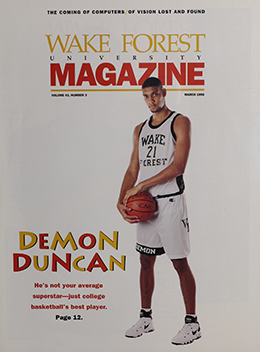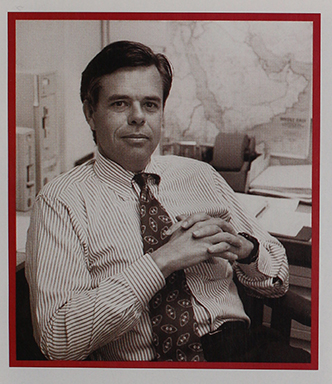This article is more than 5 years old.
Although back issues of Wake Forest Magazine can be obtained digitally via the Wake Forest Magazine website, its earliest issues were only available in print. And unfortunately, these print issues are scarce outside of ZSR Library.

The Digital Scholarship Unit and Special Collections & Archives at ZSR are bridging this gap to make digital copies from these earlier years available online at WakeSpace Digital Collections. Ultimately the digital collection will date back to the very first issue!
Wake Forest Magazine is also the newest addition to our Digital Collections. In April, we uploaded 98 issues from years 1980 through 1998 (including supplemental issues), with more to be added.
The Magazine
This publication is a standout, in part, because of its excellent feature stories. While perusing through the digital collection, you will see familiar faces on the front covers, such as Maya Angelou. Each issue is also a “Who’s Who” of Wake Forest alumni like NBA all-star Tim Duncan (‘97) and New York Times bestselling author Douglas C. Waller (‘70), who also covered several military conflicts in the Persian Gulf, Haiti and Somalia for Newsweek and Time Magazine.

Throughout the decades, the magazine has produced countless articles, class notes and other exclusive pieces pertaining to Wake Forest University. It has won several awards from the Council for Advancement and Support of Education (CASE). The current editor, Maria Henson (’82), is a Pulitzer Prize winner.
The publication was originally named “Wake Forest Alumni News” in 1928. The name evolved through the decades as “Wake Forest College Alumni News,” “Wake Forest: The University Magazine,” “Wake Forest University Magazine,” and most recently, “Wake Forest Magazine.”
The page length of each magazine varies depending on its age. This is a key indication of how vital the magazine has become throughout the years, as well as how much the university has grown.
Initial issues beginning in 1928 typically consisted of four to six pages. During the 1930s, 40s and 50s, the page number was between 16 to 30 pages. By the 1990s, some issues were at nearly 70 pages. Present-time issues, such as the Spring 2016 magazine, reaches 100 pages. Currently, Wake Forest Magazine is published three times per year, Spring, Summer, and Fall. Issues are mailed to alumni, donors, and friends of Wake Forest University.
Digitization

The digitization process began by collecting the magazine’s physical issues from ZSR’s Special Collections & Archives. Most were digitized from standalone issues. The remaining were digitized from bound volumes.
The digitization was mostly accomplished by ZSR student assistants. There were five student assistants who worked on the Wake Forest Magazine digitization project. Production was completed by using the BookDrive DIY workstation to digitize and edit the issues.
The process for digitizing each issue consists of first setting up the two Canon 35mm cameras that are mounted on the workstation by focusing and leveling the camera, and ensuring the entire page is in full view of the camera. Then pages were digitally captured in high resolution raw image files.
Editing the issues consisted of cropping and deskewing each raw image file, and then converting these pages into master files (TIFFs). From the master files, we produce the issue for public view on Wake Space as a single PDF. Thumbnail images for each issue are also created from the master files. The thumbnail images consist of the magazine covers, which is what viewers see online when they are browsing through the issues.
The next issues to be added to our Digital Collections are from years 1928 to 1953. These issues have been digitized and are currently in the post production phase.

4 Comments on ‘Wake Forest Magazine: Take A Look Back, With Digital Back Issues’
Always nice to see Tim Duncan, and I love hearing details about the digitization process! So many tasks help our collections and their content shine.
I love how, as you point out, the rise in the quality of Wake Forest Magazine parallels the rise of Wake Forest from regional to national prominence. Now that this vital publication is available digitally, ZSR and university communications can more easily tell stories of Wake Forest history via blog posts, social media, and exhibits.
Excellent write up about a very worthy project. Thanks, Mel!
This is awesome! Thanks to everyone involved for making the magazine available in digital format and helping us share the wonderful stories of Wake Forest.